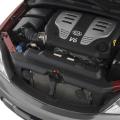Viscosity and specifications
At the factory, the engine is filled with a special multigrade oil of high quality, which is suitable for operation at any time of the year, with the exception of extremely cold climatic zones.
The engine can be topped up with other oil specifications. The viscosity grade of the oil should be selected in accordance with the data on ... If the air temperature is only briefly outside the temperature range shown in the figure, the oil should not be changed.
Petrol engines
А - multigrade oils with increased antifriction properties, specification VW 500 00.
В - multigrade oils, specification VW 501 01.
- multigrade oils, API – SF or SG specification.
Diesel Engines
A - multigrade oils with increased antifriction properties, specification VW 500 00 (for turbocharged diesel engines only mixed with oil of specification VW 505 00).
В - multigrade oils, specification VW 505 00 (for all diesel engines),
- multigrade oils, API – CD specification (for turbocharged diesel engines only if absolutely necessary for refilling).
- multigrade oils, specification VW 501 01 (for turbocharged diesel engines only mixed with oil of specification VW 505 00).
Motor oil qualities
Multigrade oils of the VW 501 01 and VW 505 00 specifications are relatively inexpensive and have the following qualities:
- the possibility of year-round use in temperate zones;
- excellent detergent properties;
- good lubricity at any temperature and engine load;
- stability of the original properties for a long time.
Multigrade oils with improved antifriction properties according to the VW 500 00 specification, in addition, have additional advantages:
- the ability to use at almost any outside temperature;
- small losses of engine power due to friction;
- make it easier to start a cold engine, even at very low temperatures.
Warnings
Seasonal oils, due to their specific viscosity-temperature properties, cannot usually be used all year round, so they should only be used in the appropriate climatic zones.
When using multigrade oils SAE 5W – 30, prolonged engine operation at high speed and constant high engine load must be avoided. These restrictions do not apply to multigrade oils with improved antifriction properties.
Additives for motor oils
Friction loss additives should not be added to engine oil.
Mixing oils
This and similar questions are of interest to many motorists. Unfortunately, oils cannot be mixed, even if these are oils from leading manufacturers (Shell, Mobil, British Petroleum). Each company produces commercial oils, adding a whole complex of additives to the oil base, the chemical composition of which is kept secret. Therefore, when mixing high-quality oils of the same purpose, manufactured in accordance with the requirements of the existing classification systems for motor oils, but using the technologies of different companies, mixtures of poor quality can be obtained due to incompatibility of additives. Oils of different companies are interchangeable; engine builders often indicate the possibility of using such oils. But this does not mean that they can be mixed. The API and ACEA classification systems presuppose mandatory identical test methods (laboratory, bench - motor, etc.) oils from different companies. If desired (or necessary), car manufacturers can introduce additional tests (or more stringent conditions) of oils.
The same applies to mixing mineral or synthetic oils (sometimes even from the same company). Synthetic oils, such as hydrocarbon oils, from the same company can be mixed. In this case, the company - the oil manufacturer gives appropriate recommendations and is responsible. Nevertheless, it is not uncommon for oils to deteriorate when mixed. As a result, the engine may clatter as the mixture of incompatible oils "jelly".
In no case should you mix imported and domestic oils, especially with the addition of domestic additives. Neither the seller nor the consumer knows the composition of the additives that are added to the oils. Some oils of "domestic origin" are produced by "firms" that do not have even basic knowledge of petroleum products. Sometimes these “specialists” use waste oils (even without proper regeneration) to produce “salable” oils. Use only oils recommended in the instruction manual.
No "cleaners" ("Tokron" and others) are able to increase the octane number of gasoline. For this, special additives are used - antiknock agents, which are added during the manufacture of gasoline at refineries, or additives. The cause of detonation (a metallic knock is heard when the engine is running) and glow ignition (the engine continues to run with the ignition off) may be carbon deposits in the combustion chamber.
The increase in compression in the system "with the introduction of some additives" does not occur due to viscous additives, since they do not have them in their composition, but for other reasons.
It is not advisable to reduce the oil burnout in an old engine and increase the compression in the cylinders by using high-viscosity oils, since this will indeed lead to an increase in the compression in the cylinders, but not for long. In the future, engine repairs will cost more.
The reason for the "acoustic" noise in an old engine is its wear, therefore, it will be cheaper to repair with the subsequent use of high quality oil. You can reduce the clearances with additives, but the expediency of this should be figured out so as not to harm the engine.
It is necessary to take as a rule: use the same brand of high-quality oil corresponding to the engine and do not mix it with synthetic (or semi-synthetic) oil. The engine will thank for this with trouble-free operation. Do not buy oil "hand-held" as the packaging is easy to counterfeit.
Changing the oil and oil filter
Periodic oil and oil filter changes are the most important preventive maintenance procedure. During operation, the engine oil ages - it becomes liquid and contaminated, which leads to premature engine wear.
An oil change should be carried out immediately after a ride on a still cold engine so that the oil can drain better together with impurities.
Raise the car on a lift or place it horizontally on a viewing ditch.
Remove the engine lower mudguard.
V6 petrol engines
Unscrew the oil filter ( ). If the filter is difficult to unscrew, use the Hazet special wrench 2171-1.
Place a container to collect oil under the oil drain hole and unscrew the plug. If necessary, push down on the plug when unscrewing to prevent oil from draining prematurely and drain the engine oil.
When the oil is completely drained, wipe off the oil around the drain hole and screw in the oil drain plug with a new O-ring.
Wipe the oil filter installation site and screw in a new oil filter.
V8 petrol engines
The oil filter is located at the rear right of the engine.
On V8-5V engines no oil drain plug on the oil filter cover.
Place a container to collect oil under the drain hole and unscrew the plug. If necessary, push down on the plug when unscrewing to prevent oil from draining prematurely and drain the engine oil.
Unscrew the bolt 1 fastening and remove the cover and the filter element of the oil filter.
Wipe the oil filter housing and cover and install a new filter element 5 ( ) the oil filter.
Lubricate O-ring 4 with fresh engine oil, install cover 3 with O-ring in place and secure with bolt 1 with a new seal 2, tightening it to a torque of 25 Nm.
Screw the plug 7 with a new O-ring 6 into the filter cover and tighten it to 50 Nm.
Wipe off the oil around the drain hole and screw the drain plug into the oil pan, tightening it to 35 Nm.
Fill the engine with the correct grade of oil.
On V8–5V engines, tighten the oil filter cover mounting bolt to a torque of 25 Nm, and the plug to the oil pan to a torque of 50 Nm.
Diesel engines V6 TDI
Remove the O-ring 2 and the filter element 3 of the oil filter.
Clean the oil filter housing and install a new filter element 3.
Install a new O-ring 2 on the cover 1 and screw the cover onto the body, tightening it to a torque of 25 Nm.
Place a container to drain the oil under the drain hole and unscrew the plug, pushing down as necessary when unscrewing to prevent oil from leaking out prematurely and drain the engine oil.
When the oil is completely drained, wipe off the oil around the drain hole and screw in the plug with a new O-ring, tightening it to a torque of 25 Nm.
Fill the engine with the correct grade of oil.
Replacement frequency:
every 15,000 km of run
Engine oils:
LUKOIL-Arctic (5W-30, 5W-40; SG / CD); "YAR-Marka Super" (5W-30, 5W-40; SG / CD); Novoil Sint (5W-30; SG / CD); "ESSO ULTRA" (10W-40; SJ / SH / CD); "ESSO UNIFLO" (15W-40; SJ / SH / CD)
It is best to drain the oil after driving while the engine is still warm. If the engine is cold, start and warm it up to operating temperature (coolant temperature 80 ° C according to the temperature gauge).
Park the vehicle on a level, horizontal surface or on a viewing ditch.
We recommend that you fill in the oil of the same brand that was in the engine. If you do decide to change the brand of oil, flush the engine lubrication system with flushing oil or oil of the same brand that you will fill in the engine. To do this, after draining the oil, fill in new oil up to the lower mark of the oil level indicator (dipstick). Start the engine and let it idle for 10 minutes. Drain the oil and only then replace the oil filter. Now you can fill in new oil.
Warning
Do not pour used oil onto the ground.
| PERFORMANCE ORDER | ||||||||||||||||||
|
||||||||||||||||||
Volkswagen Passat B3 is the flagship car of Volkswagen, released in 1988. The model was relevant until 1993 in sedan and station wagon bodies. It was a unique car compared to its predecessors, because it had a completely new platform and engines with a transverse arrangement. We are talking about gasoline internal combustion engines with a volume of 1.6 and 2.0 liters (72-136 hp), as well as diesel engines with a volume of 1.6 and 1.9 liters. Transmissions - "mechanics" or "automatic". Drive - front or full, depending on the modification. The top-end version had a VR6 2.8 under the hood with a capacity of 174 horsepower. As of 1993, 1.6 million third-generation Tradewinds were produced.
ICE oil change schedule
- the loss of basic functions by oil leads to an increase in the load on the moving components of the internal combustion engine, which negatively affects the technical characteristics of the vehicle. Severe cases include low compression, scuffing and other frightening consequences, leading to overhaul or replacement of the internal combustion engine.
- Insufficient heat dissipation, temperature rise and engine overheating. The motor works in difficult conditions and begins to quickly lose its resource, which is fraught with major repairs.
- The protective properties of the oil deteriorate, its lubricating components are lost, as a result, increased noise and vibrations occur, as well as corrosion on the internal surfaces of the internal combustion engine. The spent fluid is no longer able to fulfill its protective functions.
- The formation of dirt, chips, sludge and other deposits in old oil, which spreads through the engine channels. All this leads to unplanned financial expenses.
What engine oil is needed for the Volkswagen Passat B3
- Original - 5W-40, 10W-40
- Alternative - Castrol 10W-40, Lukoil Super 10W-40, GM Genuine 10W-40, Total Quartz Diesel 7000 10W-40, G-Energy Expert L 10W-40, 5W-40
In addition, as it turns out, new technologies have the ability to rally their fans around themselves: http://dsg7.com/
The result of this, as it turns out, may well be a case of unprecedentedly long warranty obligations - a legalized unconditional kulants. :)
"Good afternoon, Sergei! Somehow you passed diagnostics (Passat 1.8 TSI Dec 2010 run 26000) you posted a video of my engine http: //.livejournal.com/23492.html I want to share a solution to the problem (the consumption was 350-400 for warranty repairs, more than 500 are needed) 1. We go to the officials for control measurement of oil consumption, after replacing at their expense they seal the dipstick, neck, drain plug. 2. Drive 1000 km. 3. Drive to the correct auto repair shops and drain 550 g of oil through the unscrewed oil pressure sensor (taking into account the fact that the officialstopudo was poured) 4. We go to the officials when measuring the flow rate was 700g. (now it was at least 200) 5. Replacement of pistons and rings under warranty for pistons of the old model (not lightened in their words) about 100g. on 3000km.On another way with these freaks is impossible))) Sincerely, Ivan. "
Tags: What kind of oil to pour into Passat b3 1.8 mono
The pressure is the same at the bottom of the engine and at the top. Intermediate shaft without backlash. Hike ...
Apr 4 2011 - sent to the fuel and lubricants: brains, hello everyone! what oil to pour into dviglo rp 1.8 90l 1990 mono? unsubscribe who can and I am drawing a conclusion what ...





the volume of oil in the engine 1.8, trade wind, B-3 ??? | Thread Starter: Arthur
how much oil is needed in the engine 1.8, RP, B-3 trade winds? who knows the thread ???? THANK YOU VERY MUCH....
Marina 9) Fill in, naturally, fresh oil. It is better to pour through a funnel. The volume to be filled is approximately 3.5 liters. ... Next, we look at the oil level on the dipstick.
Vladislav 3.5 liters
what kind of oil to pour into Passat b3? - The Volkswagen Club ...
For the winter, synthetic was poured, Mobil 1 ™ 0W-40 is a fully synthetic oil approved by Volkswagen for cars with gasoline ...
The main indicator of the quality of an engine oil is its viscosity. It is necessary to fill the engine with oil with the optimal viscosity, the value of which depends on the design, operating mode and degree of engine wear, on the ambient temperature and other factors.
Currently, the classification of automotive engine oils according to the SAE J300 (Society of Automotive Engineers of the United States) standard is generally recognized. Oil viscosity in this system is expressed in conventional units - SAE VG viscosity grades. There are the following standard viscosity ranges for this system:
SAE 0W, 5W, 10W, 15W, 20W, 25W (winter row);
SAE 20, 30, 40, 50, 60 (summer range).
Multigrade oils combine the properties of both oil ranges. They have a combined designation such as SAE 10W-40.
Range of multigrade oils: SAE 0W-20, 0W-30, 0W-40, 0W-50, 0W-60, 5W-20, 5W-30, 5W-40, 5W-50, 5W-60, 10W-30, 10W -40, 10W-50, 10W-60, 15W-30, 15W-40, 15W-50, 15W-60, 20W-30, 20W-40, 20W-50, 20W-60.
Summer oil has enough viscosity to provide reliable lubrication at high temperatures, but is too viscous at low temperatures, making the engine difficult to start. The lightweight winter oil makes it easier to start a cold engine at low temperatures, but does not provide lubrication in summer when the engine oil temperature exceeds 100 ° C. Therefore, at present, the most common multigrade oils, the viscosity of which is less dependent on temperature. On
fig. 1.52 and 1.53 show the temperature ranges for the use of engine oils. For Volkswagen Passat engines, it is recommended to use 15W-40, 15W-50, 20W-50 multigrade oils.
Average oil consumption per 1000 km of vehicle mileage is approximately 1 liter.
The engine oil level is checked with the vehicle on a level surface 5 minutes after stopping the engine. To do this, remove the indicator 1 (Fig. 1.54) of the oil level (dipstick), wipe it with a rag, insert it completely again and then remove it again. The oil level should be between the "MIN" and "MAX" marks (see Fig. 1.54). The volume of engine oil corresponding to the level difference between the MAX and MIN marks on the oil level gauge is approximately 1 liter.
When refilling and replacing, it is necessary to use oils of the same brand, made on the same basis. When changing the brand of oil, it is necessary to flush the engine lubrication system with a special solution. Oils of the same brand with the same base, but different viscosities can be mixed without restriction.
The engine oil must be changed every 15,000 km for a gasoline engine and after 7600 km for a diesel engine. In case of infrequent use of the car, the oil should be changed at least once a year together with the oil filter.
Proceed as follows to drain the oil:
- place the car on a horizontal surface or on a lift;
- loosen the drain plug by placing a container for oil under it;
- unscrew the plug;
- wait until the oil is completely drained;
- clean the plug with a cloth, install a new seal on it;
- screw on and tighten the drain plug.
Proceed as follows to replace the oil filter:
- place a container for oil under the oil filter;
- unscrew the oil filter;
- wait for the oil to drain;
- clean the flange of the oil filter installation with a cloth;
- lubricate the gasket of the filter to be installed with new oil;
- install a new filter.
Fresh engine oil is poured through the filler neck 2 (see Fig. 1.54) located on the cylinder head cover.




